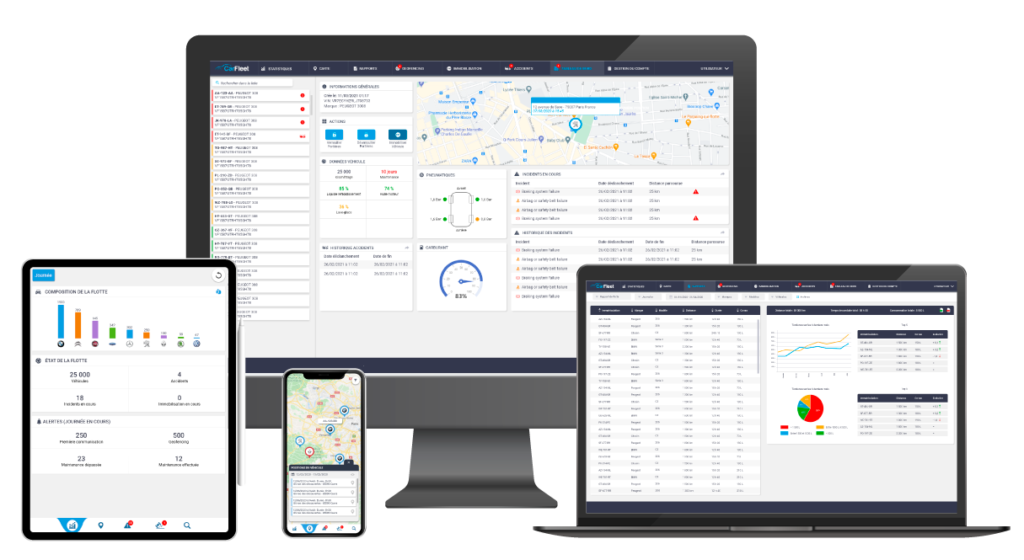
How Digital Vehicle Management is Revolutionizing Your TCO
Table of contents
Introduction
Total Cost of Ownership (TCO) is one of the most important metrics in fleet management. Companies with vehicle fleets face the challenge of optimizing their operating costs, increasing efficiency, and staying competitive at the same time. Yet many underestimate the actual costs that go beyond the mere purchase price of a vehicle.
TCO includes not only the purchase or leasing costs but also all expenses for maintenance, repairs, fuel, insurance, administration, and unforeseen breakdowns. In a highly competitive market, high operating costs can pose a significant competitive disadvantage.
Traditional fleet management solutions often rely on physical GPS trackers and telematics hardware that must be installed, maintained, and replaced. This method is expensive, labor-intensive, and carries risks. A digital vehicle management system offers a modern, cost-efficient alternative that helps companies sustainably reduce their TCO.
What is Total Cost of Ownership (TCO)?
Total Cost of Ownership (TCO) describes the overall cost of a vehicle or vehicle fleet over its entire lifecycle. It goes beyond acquisition costs and considers all direct and indirect expenses associated with operating a vehicle.
Components of TCO
Acquisition costs: Purchase price or leasing rates of a vehicle
Operating costs: Fuel, electricity (for EVs), tires, maintenance, and repairs
Administrative costs: Personnel costs for fleet management, software solutions
Insurance and taxes: Ongoing costs for vehicle coverage
Depreciation: Loss of value of the vehicle over its usage period
Through efficient TCO management, companies can reduce costs and operate their fleet more economically.
Example: How is TCO Calculated?
TCO calculations may vary depending on the company and fleet size. However, a standardized model helps capture the main cost factors:
TCO Formula:
Total Cost of Ownership = Acquisition Costs + Operating Costs + Administrative Costs + Insurance & Taxes – Residual Value
Using digital vehicle management and data-driven analyses, many of these costs can be optimized and reduced in the long term.
Cost Differences: Direct vs. Indirect Costs
It’s also important to distinguish between direct and indirect costs when calculating TCO. Direct costs are immediately linked to vehicle operation, while indirect costs are often less obvious but still significant.
Direct Costs:
Purchase or leasing fees
Fuel and energy costs
Maintenance and repairs
Insurance
Vehicle taxes
Indirect Costs:
Vehicle depreciation over time
Administrative workload for fleet management
Downtime and breakdowns
Opportunity costs due to inefficient usage
Indirect costs are often underestimated, but they can have a substantial impact on the economic viability of a fleet in the long run.
TCO Differences Between Vehicle Types
TCO varies significantly depending on the type of vehicle. Factors such as consumption, maintenance costs, and residual value play a key role in long-term cost planning.
Differences Between Vehicle Types:
Electric Vehicles (EVs): Higher purchase costs but lower operating costs due to reduced maintenance and energy expenses
Diesel and Gasoline Vehicles: Lower purchase costs but higher fuel and maintenance costs
Hybrid Vehicles: A compromise with moderate purchase and operating costs
Commercial Vehicles/Trucks: High acquisition costs but longer lifespan and specialized maintenance required
For companies, it is essential to choose the vehicle type based on the specific requirements of the fleet and the planned usage duration.
Pros and Cons: Is There a Difference Between Leasing and Buying?
The decision between leasing and buying directly affects TCO. Both models have pros and cons that should be considered according to corporate strategy.
Vehicle Leasing:
No high upfront investments
Predictable monthly payments
Regular fleet renewal possible
Can be more expensive if the term is not optimally chosen
Vehicle Purchase:
Higher initial costs
No long-term rental obligations
Possibility for depreciation
Higher administrative effort and potential resale costs
Leasing can be advantageous for companies needing high flexibility, whereas purchasing might be a better option for long-term high-mileage vehicles.
Smart-TCO: Intelligent Cost Control for Fleets
Smart-TCO is a modern approach to managing Total Cost of Ownership. It uses digital technologies and real-time data to allow for more precise and dynamic calculation of fleet costs.
Benefits of Smart-TCO:
Real-time monitoring: Ongoing analysis of vehicle performance and costs
Dynamic optimization: Adjust driving behavior and maintenance schedules to lower operating costs
Integration with digital vehicle management systems: Use OEM data for accurate cost calculations
Automated reports: Transparency over all cost drivers
Companies that rely on Smart-TCO benefit from data-based decision-making and significant savings potential.
But how can you implement this approach in your company? We’ll show you!
Digital Vehicle Management Without Add-On Devices
Digital vehicle management is based on the use of manufacturer-provided vehicle data (OEM data) taken directly from the vehicle’s built-in telematics. This method allows for precise and automated capture of all relevant vehicle information—without additional hardware or aftermarket installations.
The technology uses cloud-based systems and APIs to integrate vehicles seamlessly into existing software solutions. Fleet managers gain real-time visibility into the entire fleet, including mileage, fuel consumption, maintenance status, and even potential vehicle failures.
Advantages Over Traditional Systems:
No installation effort: No physical devices, no mounting costs
Higher data precision: Direct vehicle data instead of aftermarket sensors
Immediate scalability: New vehicles can be added easily
Multi-brand compatibility: Works independently of the vehicle manufacturer
Optimize & Reduce Your TCO With Echoes
The offering includes CarFleet for digital fleet management with live data and CO₂ reporting, CarLocate for location tracking and theft protection using OEM data, and CarCollect for seamless API integration into existing software systems. With these systems, companies receive an innovative solution to manage their fleets more efficiently and benefit from a wide range of advantages:
No Hardware Investment Costs
One of the biggest benefits of digital vehicle management is the elimination of hardware investments. Traditional telematics systems require purchasing GPS trackers, sensors, and other devices that are not only expensive to acquire but also maintenance-intensive. Digital solutions use existing vehicle data, so no additional hardware components are needed. This saves money and significantly reduces logistical effort.
Real-Time Data for Better Planning
With digital solutions, fleet managers can retrieve and analyze key vehicle data in real time. This includes:
Automatic mileage tracking for accurate billing of lease and service contracts
Live maintenance status to avoid vehicle breakdowns early
Error messages and diagnostic data to proactively plan repairs
Reduce Fuel and Energy Costs
Digital vehicle management enables detailed analysis of fuel and energy consumption. Companies can:
Conduct driving behavior analysis to identify inefficient driving
Use CO₂ dashboards to reduce emissions and make sustainable decisions
Optimize EV management by monitoring charging levels and consumption data
Less Administrative Effort, More Efficiency
Many administrative processes in fleet management are time-consuming and error-prone. Digital solutions automate many tasks, including:
TCO calculations and reports at the push of a button
Digital logbooks for tax and compliance processing
Digital invoicing and fuel card billing for cost control
The Next Step in Your Vehicle Management: CarFleet

Digital vehicle management offers companies a modern, efficient, and cost-saving alternative to traditional fleet management solutions. By eliminating hardware costs, using real-time data, and automating administrative processes, the Total Cost of Ownership (TCO) can be significantly reduced.
Take the next step and optimize your vehicle fleet with Echoes!
FAQ: What You Should Know to Reduce Your TCO
Why is Total Cost of Ownership often underestimated?
Many companies only look at the direct costs of a vehicle, such as purchase and fuel. Indirect costs like downtime, administrative workload, or depreciation are often overlooked, yet they can significantly impact overall costs.
How does digital vehicle management work without additional hardware?
Digital vehicle management uses direct OEM data (manufacturer data) from the vehicle’s built-in telematics. Cloud-based systems and APIs seamlessly integrate vehicles into existing software systems without the need to install GPS trackers or sensors.
How does digital vehicle management specifically help reduce TCO?
Through real-time data analysis and automated processes, companies can:
Reduce maintenance costs by responding early to errors and wear
Cut fuel and energy costs through driving behavior analysis and optimized usage
Minimize administrative workload through digital logbooks and automated billing
Avoid downtime by proactively scheduling repairs and service appointments
Does vehicle tax affect the Total Cost of Ownership?
Yes, vehicle tax can have a significant impact on the total cost of ownership, especially when operating large fleets.
Factors that influence vehicle tax:
- CO₂ emissions: More environmentally friendly vehicles are often favoured in terms of tax.
- Vehicle type: Electric vehicles are favoured for tax purposes in many countries.
- Engine capacity and power: Higher-powered vehicles often have higher tax rates.
Choosing the right vehicles can therefore not only reduce operating costs, but also bring tax advantages.